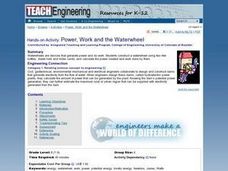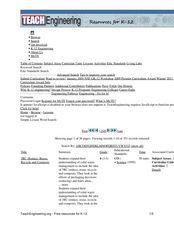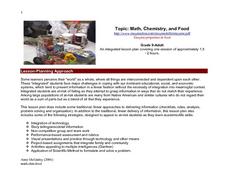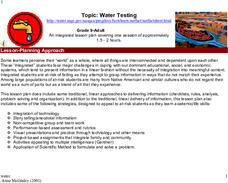Curated OER
Weather "Toons
Student use a variety of resources including print, CD-Rom and Internet information to study a weather process. They design a weather cartoon citing the bibliographic sources from their research.
Curated OER
Measurement of the Depth of the Ocean
Students comprehend the physical properties of pressure and Boyle's Law by designing a depth gauge. They construct a capillary depth gauge and calculate the calibrated depth marks of the capillary tube. They determine the margin of error...
Curated OER
Creating a Job Community
Students design their own job communities. In this art and career exploration lesson, students are placed into groups to create models of business areas based on job types.
Curated OER
Couch Potato or Inertia Victim?
Sixth graders how primary research is carried out. They design a simple survey questionnaire to interview people about their week average television watching time. They analyze the results and write a report based on the information.
Curated OER
Power, Work and the Waterwheel
Students use a two-liter bottle, dowel rod and index cards to design and construct a water wheel. They then calculate the power created and measure the work done by the water wheel in Watts and Joules.
Curated OER
Where's the Water?
Fifth graders conduct an investigation into water purification during a role play situation in an Amazon Rainforest. They design a scientific experiment for cleaning and filtering water.
Curated OER
TE Activity: A Merry-Go-Round for Dirty Air
Students observe a simulation of a cyclone to examine a method of pollutant recovery in cleaning industrial air pollution. They examine how engineers develop technology to reduce air pollution and determine percentages for technology...
Curated OER
TE Activity: Build Your Own Mobile
Learners inquire into how the center of mass is the key factor in designing cars. They construct an oddly shaped object and determine its center of mass. They find that engineers are able to predict how objects will behave while they are...
Curated OER
TE Activity: The Boxes Go Mobile
Students create a mobile of boxes and cubes that they made in a previous lesson that can be accessed from this page. They design the mobile using method that an engineer would use to balance the items based on surface areas and volumes.
Curated OER
Topic: Math, Chemistry, and Food
Students listen as the teacher tells the story of Sisyphus rolling the stone up the mountain. Students prepare two batches of jello, one with fresh pineapple, and one with canned pineapple. While the jello is setting, students work on...
Curated OER
Water Testing
Students work together to design their own experiment to test developed hypothesis about the minerals in water. As a class, they discuss the main components of water quality and describe the chemistry behind the hardness assay. They...
Curated OER
Eye From the Sky
Students are introduced to the concept of aerial perspective and scale. Students will use satellite technology to view their neighborhoods and sketch the area surrounding their schools. They will take part in a neighborhood walk to view...
Curated OER
Planetary Landers
Students watch programs from a series titled "Planetary Landers". As a class, they view a poster of various vehicles that have made their way into space. In groups, they brainstorm the characteristics that should be included when...
Curated OER
Student Led Staff Development: A Teen's Definition of Crisis
High schoolers research an area that is relavent to their age level that concerns them. They work together to create a presentation to give to the faculty. They must use technology in their presentations.
Curated OER
Breaking Beams
Students work together designing and building their own beams. They discover the concepts of stress and strain. They participate in a competition to determine the best beam.
Curated OER
How Do Things Fall?
Students observe falling objects. They discover the rate of falling is based on air resistance and not the weight of the objects. They discuss how engineers use this type of information to design aerodynamic shapes.
Curated OER
MOBILITY, Traveling Lightly: What’s My Footprint?
Students calculate their carbon footprint. In this environmental technology lesson, students listen to a lecture on climate change. Students brainstorm solutions to reduce environmental impact based on travel options. Students calculate...
Curated OER
Illustrate With Character
Learners examine character traits and apply characteristics of those traits to images and quotations. They design, save and print using a desktop publishing program. They utilize reference tools to locate quotations.
Curated OER
PAPER RECYCLING
Students examine the availability and use of important resources, people practice conservation. They explore the needs of an expanding human population, societies practice resource management and employ technology.
Curated OER
Musical Plates
Sixth graders engage in a study of the plates and how they are part of the formation of the ever changing landscape of planet earth. They access web sites that have applications for observation and conducting different activities. The...
Curated OER
Toy Planet
Students design a toy store, supply it with merchandise (on paper) and create advertisements. They also manage the store's debits and credits by using a spreadsheet. They consider how to promote the sale of their merchandise.
Curated OER
Irish Eyes: Taking a Look at Local Landscape
Students create landscape flyers of local landscapes using digital photography, educational software, and examples of Irish landscapes. This creative-project lesson lasts two weeks, including class time spent collecting photographs...
Curated OER
Ultimate Ride Coaster Deluxe
Eighth graders describe the energy transformations as cars travel over a roller coaster. They explain the principle of conservation of energy as it relates to a roller coaster ride. The integration of technology is done using educational...
Curated OER
Does Contact Area Matter?
Students work together to design and implement an experiment on friction. They test to see if contact area affects the amount of friction. They discover how engineers use friction to make certain products better.

























